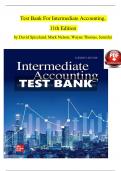Examen
TEST BANK For Intermediate Accounting, 11th Edition by David Spiceland, Mark Nelson, | Verified Chapters 1 - 21 | Complete Newest Version
- Grado
- Institución
TEST BANK For Intermediate Accounting, 11th Edition by David Spiceland, Mark Nelson, | Verified Chapters 1 - 21 | Complete Newest Version TEST BANK For Intermediate Accounting, 11th Edition by David Spiceland, Mark Nelson, | Verified Chapters 1 - 21 | Complete Newest Version
[Mostrar más]



